Massive iceberg almost the size of Greater LONDON breaks off Antarctica’s Brunt Ice Shelf
>
A humongous iceberg has broken off the Brunt Ice Shelf in Antarctica, just 12 miles (19 km) away from where British scientists are working in a research station.
The iceberg has a thickness of 490 feet (150 metres) and an area of 600 square miles (1,550 km²) – almost the size of Greater London.
It broke off at a huge crack that bisected the ice shelf, known as Chasm-1, which had been growing by about 2.5 miles (4 kilometres) each year since 2012.
GPS sensors began to pick up movement at Chasm-1 between 7pm and 8pm on Sunday, when it extended to roughly 40 miles (60 kilometres), across the entire shelf.
The iceberg broke off at a huge crack that bisected the ice shelf, known as Chasm-1 (pictured), which had been growing by about 2.5 miles (4 km) each year since 2012

GPS sensors began to pick up movement at Chasm-1 between 7pm and 8pm on Sunday, when it extended to roughly 40 miles (60 km) long – across the entire shelf
Fortunately, all of the 21 staff working at the Halley Research Station with the British Antarctic Survey (BAS) were completely safe, and had been preparing for this eventuality.
Professor Dame Jane Francis, Director of BAS, said: ‘Measurements of the ice shelf are carried out multiple times a day using an automated network of high-precision GPS instruments that surround the station.
‘These measure how the ice shelf is deforming and moving, and are compared to satellite images from ESA, NASA and the German satellite TerraSAR-X.
‘All data are sent back to Cambridge for analysis, so we know what is happening even in the Antarctic winter – when there are no staff on the station, it is dark for 24 hours and the temperature falls below -58°F (-50°C).’
The glaciologists have confirmed that the area of ice the station is situated on remains unaffected by the event.
In 2016, continuous growth of Chasm-1 prompted the BAS – the national polar research institute – to relocate the site 14 miles (23 kilometres) inland.
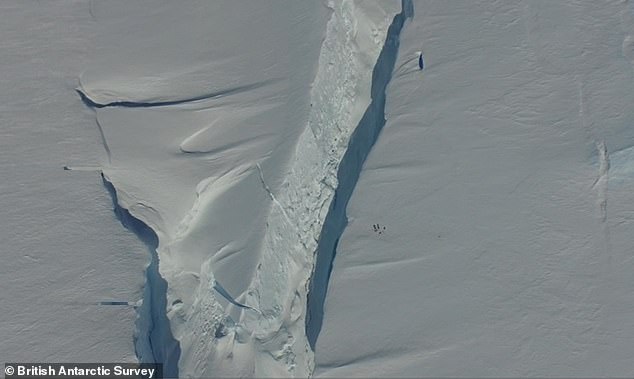
Chasm-1 (pictured) had lain dormant for the 25 years prior to 2012, when satellite monitoring revealed it was starting to move
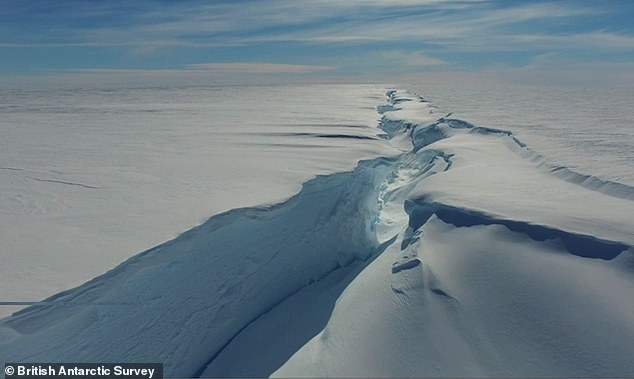
While this won’t be the largest iceberg to split off from Antarctica, it’s the biggest chunk the ice shelf has lost since observations began over 100 years ago in 1915. Pictured: Chasm-1
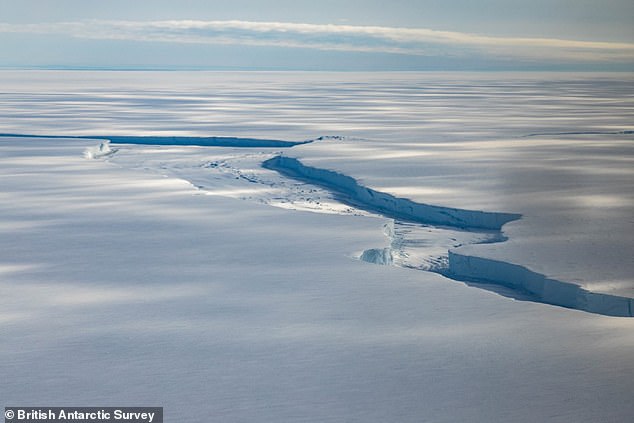
The weekend’s ‘calving event’ was completely natural – not at all linked to climate change – and caused by a spring tide. Calving is a natural occurrence caused by the forward motion of a glacier making its end unstable
The weekend’s ‘calving event’ was completely natural – not at all linked to climate change – and caused by a spring tide.
Professor Dominic Hodgson, BAS glaciologist, said: ‘This calving event has been expected and is part of the natural behaviour of the Brunt Ice Shelf.
‘Our science and operational teams continue to monitor the ice shelf in real-time to ensure it is safe, and to maintain the delivery of the science we undertake at Halley’.
Calving is a natural occurrence caused by the forward motion of a glacier making its end unstable.
During a calving event, part of the end of a glacier drops off, often forming an iceberg.
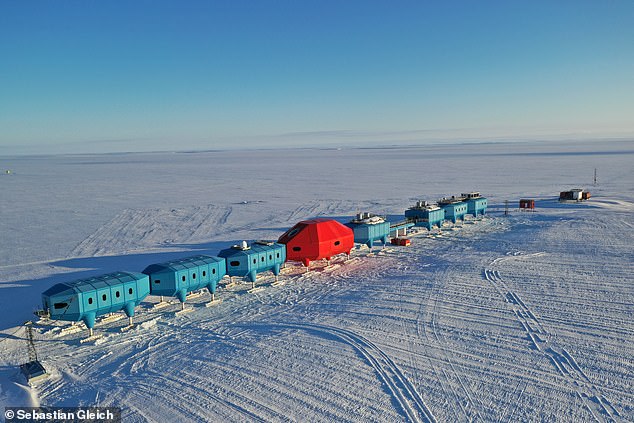
The Halley VI Research Centre (pictured) is an internationally important platform for atmospheric and space weather observations in a climate-sensitive zone
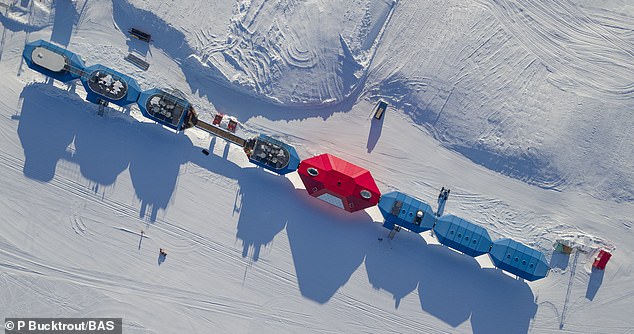
It sits on the Brunt Ice Shelf, that floats on the frozen continent and flows at a rate of about 1.5 miles per year.

Staff are deployed at the station between November and March to maintain the facilities that allow them to monitor experiments remotely during the winter
While this won’t be the largest iceberg to split off from Antarctica, it’s the biggest chunk the ice shelf has lost since observations began over 100 years ago in 1915.
Chasm-1 had lain dormant for at least 35 years prior to 2012, when satellite monitoring revealed it was starting to move.
In 2015 and 2016, scientists used ice-penetrating radar technologies and satellite images to determine the path the fracture could take, and the speed it could grow.
By December, Chasm-1 was slicing across the majority of the ice shelf, marking the beginning of the calving event.
The iceberg it has formed, which will be named by the US National Ice Center, is predicted to drift into the Weddell Sea, but glaciologists will track its movement.
The Halley VI Research Centre is an internationally important platform for atmospheric and space weather observations in a climate-sensitive zone.
It has been unoccupied during the last six winters because of the complex glaciological situation which makes the impact of calving events unpredictable.
However, staff are deployed there between November and March to maintain the facilities that allow them to monitor experiments remotely during the winter.
Those currently on site are due to be collected by aircraft around 6 February.
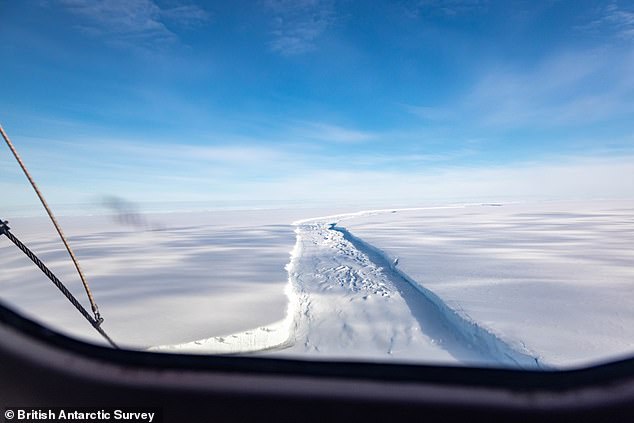
The Brunt ice shelf is made from glacier ice that has flowed off the land in Antarctica and floated out to sea.
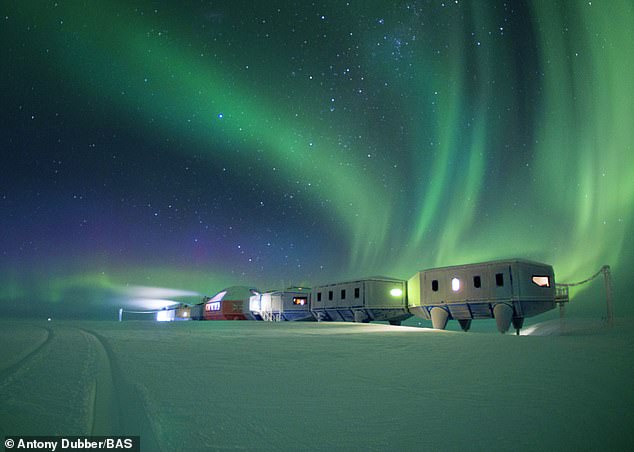
All of the 21 staff working at the Halley Research Station (pictured) with the British Antarctic Survey were completely safe, and had been preparing for this eventuality
This is the second major calving from the Brunt Ice Shelf in the last two years, with the first occurring in February 2021.
In November 2020, a major fracture – called the North Rift – began carving its way through the ice and continued to extend through the start of the new year.
This accumulated in a 490 square-mile (1,270 km²) iceberg, called A74, splitting off the vast floating ice shelf and drifting into the Weddell Sea.
The Brunt Ice Shelf is made from glacier ice that originally fell as snow on Antarctica and has flowed off the land and out to sea.
It flows at a rate of up to 1.2 miles (2 km) per year west towards the sea where, at irregular intervals, it calves off icebergs.
In 2021, an iceberg with an area of almost 500 square miles grazed past the western Brunt Ice Shelf, but it did not split Chasm-1.
There was concern that if it had hit West Brunt harder, it would finally cause the block to break off from the main ice shelf and create the new iceberg.
